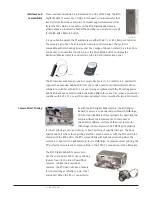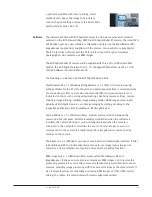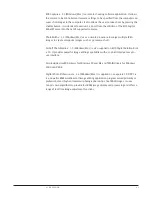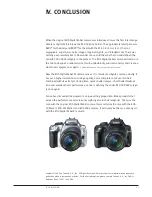
III. DISCUSSION
19
Exposure Controls
The EOS Digital Rebel XT camera offers a broad and flexible range of exposure controls.
In the Basic Zone modes, evaluative metering, linked to all 7 AF points, is automatically
selected. In the Creative Zone modes, partial metering at the center (9% of the
viewfinder) and centerweighted average metering are also available. Pressing the left
cross key displays the Metering Mode menu.
Eight exposure modes offer a total of 14 different options:
Program AE (shiftable), Shutter-priority AE, Aperture-
priority AE, Auto Depth-of-Field AE (A-DEP, non-shiftable),
Full Auto (Program AE, non-shiftable), six Programmed
Image Control modes (Portrait, Landscape, Close-Up,
Sports, Night Portrait, Flash OFF), Manual exposure
(including Bulb), and E-TTL II autoflash program (C. Fn.
8-0: Evaluative metering, C. Fn. 8-1: Averaged metering).
The range of available ISOs is from 100 to 1600. In the Basic Zone modes, the ISO
cannot be set manually, whereas in the Creative Zone modes, the ISO cannot be set
automatically. Pressing the top cross key displays the ISO speed menu.
Manual exposure compensation is enabled in each of the Creative Zones except Manual.
Bracketing can extend to +/- 2 stops in 1/2 or 1/3 stop increments. Depending on the
shooting mode, either shutter speed, aperture, or both can be varied. Auto exposure
bracketing, AEB, is available in the Creative Zone modes and is set with the on-screen
menu. The bracketing sequence is, first, the standard exposure, then decreased
exposure and, last, increased exposure. The range is the same as with manual
bracketing. Conveniently, auto exposure bracketing can be used in combination with
white balance bracketing, in which case nine images are generated.
Both auto and manual AE lock are available in Creative Zone AE modes. In the One-Shot
AF mode with evaluative metering, AE lock takes effect when focus is achieved. During
evaluative metering, AE lock centers on the selected AF point. During partial metering at
the center, or with centerweighted averaged metering, AE lock fixes on the center AF
point. Normally, manual AE lock is enabled with the AE lock button. Pressing the button
again renews the AE lock in the event of subject or camera movement. When the built-in
flash or an EX-series Speedlite is used, the AE lock button works as an FE lock button.
Viewfinder








































